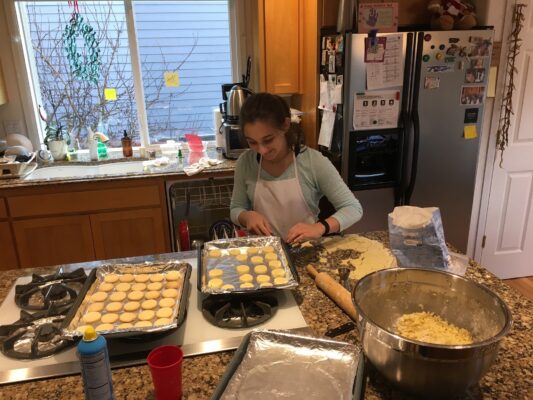It’s the 23rd of December and the kitchen is packed. The island in the middle of the kitchen is filled with plates of dirty utensils, raw meat, kneaded dough, and spices. The sound of the water faucet running in the kitchen, the loud music being played from the speaker, and the joyous laughter coming from the kids overwhelms the neighbors. The only thing breaking the kitchen apart from the living room is a loveseat with a light brown hue that becomes brighter once the light touches it. It is placed a few feet away from the fireplace that is decorated with stockings, while Christmas cards from my friends and family cover the mantle. The love seat is next to the Chritsmas tree which is decorated with colorful lights and holiday ornaments.
My aunts, uncles, and cousins have come to visit my family for Christmas. Every holiday that we come together, my mom, dad, siblings, and I always have the best Christmas.
As my family prepares for Christmas day, the boys of the family are running around the house with a gigantic piece of pork called pernil. My mom and aunt are boiling condensed milk in a pot to make the smooth dulce de leche that every family member’s mouth waters for, all while the kids are trying to find the perfect Puerto Rican Christmas playlist.
My mom was born and raised in Argentina, and my dad was born and raised in Puerto Rico. This is Christmas to me: family from both sides, traditional foods, music, and chaos in the kitchen that creates the most memorable 24th and 25th of December.
Religion is closely tied to my culture and the family traditions from both sides. My family believes that Christmas is the day Jesus was born. This holiday is a time of grace, hope, gratefulness, happiness, friends, and family. My parents have always taught my siblings and I the importance of family, especially during the holidays.
One of the most important traditions is the food that is prepared in advance. These dishes are prepared with thoughts of love and generational connection. For example, on the 23rd of December, we prepare specific dishes for Christmas Eve and Christmas day. We spend all day preparing these dishes in the comfort of our kitchen in great anticipation for the Christmas festivities.

Alfajores de maicena is the first dish that comes to mind, not only because it is my favorite dessert, but also because of the memories that I share with my mom. Alfajores de maicena are an Argentina dessert that my mom and I make together every Christmas. She first taught me how to make these delicious coconut and dulce de leche cookie sandwiches when I was 10. On the 23rd, we spend the whole day making them together. The cookie top and bottom are the hardest to make– they need to be kneaded and cooked just right so that when you take a bite, they instantly crumble in your mouth, mixing with the smooth dulce de leche center.
“Alfajores de maicena have always been my favorite dessert and stayed close to my heart ever since my mom, your abuela, taught me how to make them,” my mom says. “…I love being able to share this tradition with you every year just like my mom did with me.”
Alfajores de maicena are believed to have originated in Spain under Muslim rule. Scholars believe this dessert was brought to South America with the first Spanish conquistadors, around the 15th century. This is a very traditional Argentinian dessert that is not only baked during the holidays, but rather is enjoyed throughout the whole year!
Another important element is coquito. Coquito is a traditional Puerto Rican holiday drink that’s made with coconut, rum, vanilla, spices, and sometimes egg yolks or raisins. Coquito is sweet, thick, and creamy, and the coconut provides most of its flavor and texture.
The name coquito means “little coconut” in Spanish. Some believe that the Spanish brought a version of coquito to the Caribbean during Puerto Rico’s colonial era. The drink was originally made with Caribbean rum, but Puerto Ricans added coconut to make it their own.
“People make their coquito differently based on their family’s tastes. For the Berríos, we have always liked more raisins and cinnamon,” says my dad.
Another theory is that coquito originated during Prohibition in Puerto Rico. Prohibition was a period in Puerto Rico where the United States government prohibited the production of alcohol on the island. To avoid detection, islanders mixed liquor with coconut milk, which made it difficult to smell the alcohol. Although there are many similar recipes out there (most often mistaken as eggnog), coquito is a delicious traditional drink that was created based on the culture of Puerto Rico’s peoples and Spanish conquistador experiences.
Another traditional Puerto Rican dish is the pernil asado. This is a slow roasted pork with many different Puerto Rican seasonings rubbed on. Pernil comes from the Spanish word pierna, which means leg in English and is the Catalan word for ham.
If you happen to be having this on the island, more than likely they will be making a lechon in a caja china. Lechon is the whole pig cooked to perfection and roasted in a caja china. A caja china is a wooden box covered in hot coal and platano leaves where the lechon is slow cooked from 6 to 12 hours. Pernil is made all over Latin American countries and the many Caribbean islands.
“The seasonings used on pernil asado are the best of the best that Puerto Rico has to offer. Although Adobo will always be my favorite, the combination of so many different delicious spices on pernil asado is the basis of Puerto Rican cuisine,” says my dad.
There are many more traditional Puerto Rican and Argentinian dishes that are prepared, but the ones listed here are my favorite. So many memories are created when my parents share their traditional cultural foods, and I get to experience both.
My mom shares, “One of my favorite memories is when we slow roasted el lechon en la caja china on New Year’s Eve. Not only was the food terrific, but the company was even better.”
All of these recipes are important to me, not only because of their traditional significance (especially during the Christmas season), but because cooking food in my family is a way of passing down culture, history, and knowledge. Moreover, just as my abuelos taught my parents, and my parents are teaching my siblings and me, we will continue to honor tradition and the importance of Christmas.
Lilian was a fellow in the 2024 Story Gathering Workshop, a program that gives young writers the opportunity to publish an article for our news outlet, Voices.

Be a part of our movement to share and celebrate the diverse stories of our ethnic communities
Our Northwest cultural communities have powerful stories to tell. Your support can help us amplify these voices. Donate $5 or $10 today and follow us to stay connected with the latest updates.